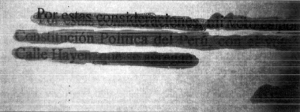“I was surprised to discover that 35 pages of the resolution were adulterated with liquid paper, covering lateral signatures and altered contents.”
— Augusto Pratel Rada, Agrarian Reform Bondholder who discovered the forged ruling
Diario Exitosa, 6/28/15

As jilted bondholders grew increasingly agitated, Peru’s highest court prepared to reaffirm its 2001 decision ordering the government to repay the agrarian reform bonds at a fair price. However, the Executive Branch voiced its opposition and intervened, compromising judicial independence. The court then issued a forged ruling—doctored with white-out and a typewriter—which virtually eliminated Peru’s agrarian reform debt obligation. Authorities have made one arrest in the forgery scandal and continue to investigate.
The Lima police analyzed the Constitutional Tribunal’s fraudulent ruling using a forensic light source and other investigative tools. The image below is one of many examples of forgery included in the subsequent police report, which states that “white correction fluid was applied to the third paragraph to hide the previous text” in this section of the ruling. READ THE REPORT >

The Crime
Court Set to Reaffirm 2001 Ruling
Justice Gerardo Eto presents a draft decision requiring full repayment of the agrarian reform bonds according to the CPI methodology, making them worth several billion dollars in total. Four of six justices vote in favor of the decision, including Justice Oscar Urviola, the Tribunal’s president.
President Humala Opposes Draft Decision
Peruvian President Ollanta Humala hears of the forthcoming decision and publicly states the Tribunal should refrain from ruling on “sensitive cases” like the agrarian reform bonds since several justices are nearing the end of their terms. (Today, Humala is being jailed pending an unrelated corruption investigation.)
Executive Branch Interference
Justice Eto circulates a final draft with his signature on each page, and the final vote is scheduled for a plenary session July 16. However, that night—after office hours—an advisor to Humala visits the Constitutional Tribunal and meets with Urviola, according to visitor logs.
Suddenly, New Draft Supports Dollarization
At the plenary session, a mysterious new draft decision suddenly emerges adopting the “dollarization” method of calculating the value of the agrarian reform bonds. Meanwhile, someone has used white-out and a typewriter to transform the previous draft into a forged “dissent” purportedly written by Justice Carlos Mesia. The scandal will not be uncovered for nearly two years.
Forged Decision Hastily Approved
Urviola now votes in favor of dollarization. On the basis of the fraudulent “dissent,” he declares the panel deadlocked at 3-3 and allows himself to cast a tiebreaking vote. This gives the dollarization ruling the four votes needed to be considered an opinion of the Constitutional Tribunal.
Criminal Investigation
Bondholder Discovers Forgery
Augusto Pretel Rada, an agrarian reform bondholder, reviews a scanned copy of the Constitutional Tribunal’s 2013 ruling and realizes it has been doctored. He files a complaint with the Public Prosecutor’s Office in Lima, sparking a criminal investigation.
Chief Justice Admits Ruling Was Doctored
A Peruvian newspaper, Diario Exitosa, publishes a number of news articles on the scandal, including an interview with Urviola in which he admits to the use of white-out on the 2013 decision.
Authorities Confirm Forgery
A prosecutor in Lima inspects the records of the Constitutional Tribunal and determines the file contains a number of irregularities, including erasures, white-out, and “overwriting.” Forensic investigators arrive at similar conclusions.
Former Justice Files Criminal Complaint
Mesia files a complaint with Lima prosecutors over the 2013 “dissent” that was forged in his name. He alleges Urviola did not allow him to submit a legitimate dissent.
Court Clerk Arrested for Forgery
Oscar Diaz, the Secretary Reporter of the Constitutional Tribunal, is charged with falsification of court documents in the white-out scandal.
Clerk Admits to Altering Ruling
At a hearing on the charges against him, Diaz acknowledges he was not authorized by Mesia to alter the document that would be filed as his “dissent.” In the wake of this admission, Diaz publicly resigns from his position.
Congress Moves Forward with Charges Against Urviola
Congress’ Permanent Commission unanimously approves an investigation into the forgery allegations against Urviola, the former Chief Constitutional Tribunal Judge, filed by Pretel and another bondholder.
Probe Continues After Arrest
The forgery scandal remains the subject of an ongoing criminal investigation. Nonetheless, not a single Peruvian government official has publicly condemned the forgery, and the decision is still posted on the court’s website.